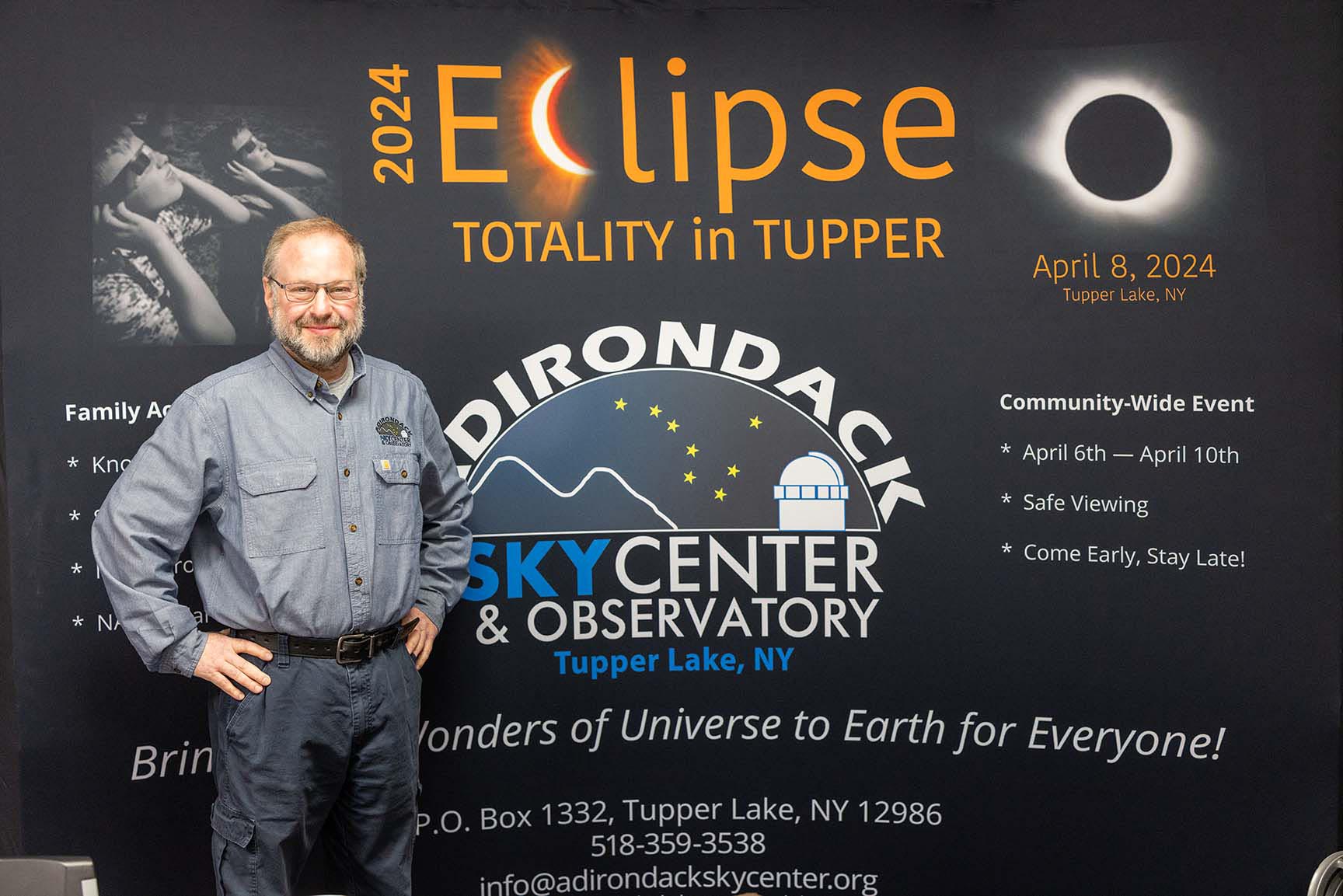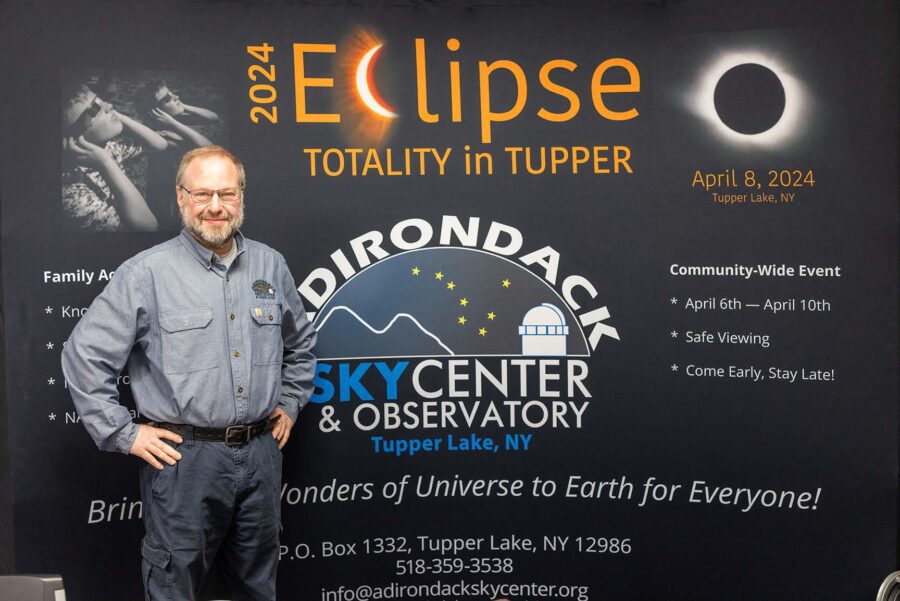
Spring break event timing brings unique challenges
By James M. Odato
If event planners, history and hotel bookings point the way, the Adirondack Park will draw thousands of visitors April 8 for what some are billing a show of a lifetime – a total solar eclipse that will darken the afternoon sky in the High Peaks for some of the longest durations in the Northeast.
Yet interviews among those preparing for events in the park reveal a need to plan for the crowds expected to come. Among the concerns: The potential crush of overnight visitors and day-trippers that could clog two-lane roadways and tax community services. Businesses used to closing or running with scaled back staff during the spring break shoulder season commonly referred to as “mud season.”
One of people sounding the alarm is Seth McGowan, president of the Adirondack Sky Center & Observatory in Tupper Lake. He has been meeting with community leaders for months trying to plan festivities and amenities for the expected rush.
“This is a national event,” he said. “This is not something we asked to be in the path of. We have zero control of how many people will be coming to the area, just short of taking ads out in the New York Times saying ‘do not come.’ They’re coming.”
A focus on the Tri-lakes
According to McGowan, said many astronomy buffs and eclipse chasers are focused on the Tri-lakes region, comprised of Tupper Lake, Saranac Lake and Lake Placid. In Tupper, a committee has planned staging areas, talks, museum visits and other features, including a NASA livestream, around the park’s only observatory for a “Totality in Tupper” celebration. His nonprofit has secured 50,000 sets of protective eyewear to hand out and sell along with mugs, shirts and other merchandise.
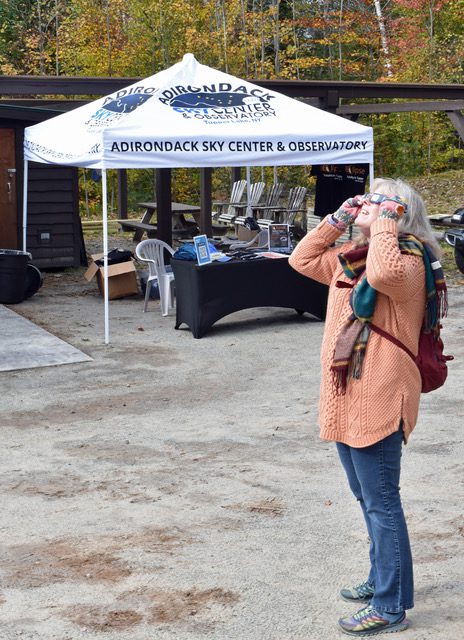
A street fair in Saranac Lake and special Lake Placid viewing opportunities at Whiteface Mountain and Olympic facilities are adding to the attraction of the region where the total eclipse of the moon covering the sun will be on display for some 3 minutes and 33 seconds, considered a great deal of time for such a rare natural phenomena.
Yet, five months before the three Adirondack villages expect to welcome sky-gazers and show off the region, tourism officials, police, highway departments and government leaders are scurrying to make sure bathroom facilities, parking and trash cans are available and that safety can be assured.
And they’re hoping restaurants, businesses and emergency services workers will stick around on a school-break week when many residents are in the habit of leaving the mountains for warmer climes.
An objective for planners is for visitors to enjoy themselves and leave with a positive feeling about the region, said Mary Jane Lawrence, chief operating officer for the Regional Office of Sustainable Tourism. ROOST has been sending out emails about the event for months to get the word out about viewing the eclipse in the Adirondacks.
Planning is incomplete, Lawrence said, as many interested parties continue to discuss gaps in traffic control coordination and services needed. ROOST is scheduling outreach meetings in communities expected to be popular stops and maintains a website for information.
“Our first and foremost initiative is to find designated viewing places that will discourage people from being everywhere and anywhere in the Adirondacks for safety,” Lawrence said.
“We have some metrics to follow: occupancy and historically what we know from other destinations to understand what the impact will be,” Lawrence said. “Some businesses will take advantage of it; some will opt out and go south.”
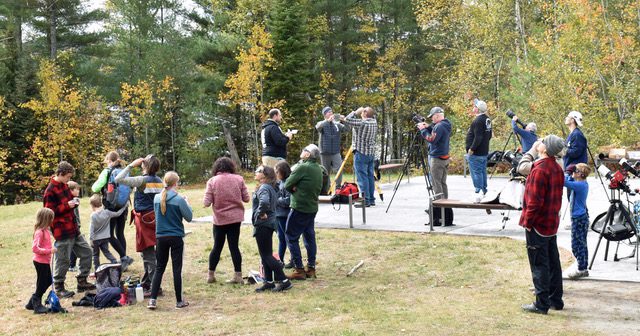
A total eclipse will shroud the area in darkness this coming April 8th and may allow viewing of the solar corona. After that, the next opportunity for seeing a total eclipse in the Continental United States won’t occur until 2045. Photo by Tom French
How many people to expect?
Marketing has been too widespread for some local officials. Town of Tupper Lake elected leaders recently asked organizers to ease up on promotion as it appears plenty of guests will be arriving, although no one can say how many.
If a fraction of the turnout seen in some past eclipse destinations make their way to Adirondack towns, it could be a strain on services.
“We don’t want to invite more people to the area,” said Tupper Lake Council Member Mary Fontana, who will become the community’s mayor in December. “We don’t have the infrastructure.”
Her caution is based partly on the uncertainty of the weather – an April snowstorm could trap visitors – and certainty that many locals will go on vacation. She herself will be aboard a cruise the week of the eclipse when she gets married. She expects municipal department heads will not allow many employees to take time off that week.
“We would like to be prepared whether we get three people or 3,000,” Fontana said.
The region may get something closer to the bigger number, said McGowan, who attended the last major eclipse event, traveling to Hopkinsville, Kentucky. The city of 30,000, nine times larger than Tupper Lake, drew 116,000 visitors when it was in the path of totality on Aug. 21, 2017, with views of 2 minutes and 40.1 seconds. City officials say the community collected $28.5 million in economic benefits from the event.
“It was life-changing,” said Brooke Jung, Hopkinsville’s director of tourism, who helped plan a citywide festival around the eclipse with events for a price and three-day minimum camping sites at all local parks. “I can’t think about it or talk about it without getting goosebumps.”
Jung said the planning was successful and people – who came from more than two dozen countries and most states – enjoyed themselves despite traffic slowdowns. Hopkinsville received state resources, including the National Guard, she said.
McGowan watched the eclipse from a Hopkinsville Walmart and described it as thrilling. He said the exit was difficult, taking 11 hours to drive to Lexington, normally a three-hour trip, and that towns along the way ran short of gasoline, food and restroom necessities.
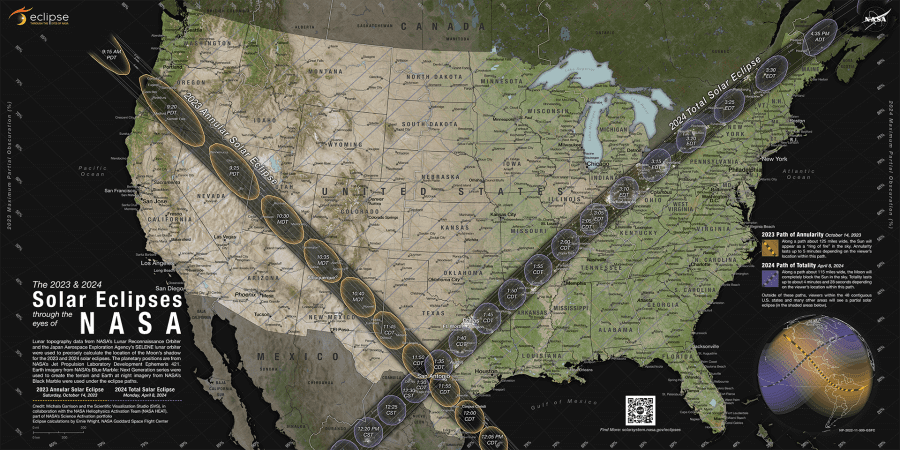
Will the state step in to offer support?
“Anybody that is in the path of totality will see an increase of business,” said ROOST’s Lawrence. She and other officials preparing for the celestial happening are hoping the Hochul administration will assist with safety, including notices for people to avoid trails to the peaks, which will likely be snow-covered. The state’s I Love NY program is working on the project, she said.
A Hochul spokesman said her office has maintained regular communication for over a year with local governments and municipalities statewide, especially those within the path of totality. “These communications will continue leading up to the eclipse,” said Jason Gough, the governor’s deputy communications director. “In addition to the state’s normal jurisdictional role over state parks and state roads, it stands at the ready to provide logistical support for municipalities.”
How other parts of the Adirondacks are preparing
Beyond the High Peaks, Adirondack regions that will offer lengthy viewing of the eclipse include Old Forge and Inlet to the west and Indian Lake and Ticonderoga to the south. Those areas report mixed levels of awareness and preparedness.
Mike Farmer, tourism director for the town of Webb, said the Old Forge area may lose workers to vacations and snow may cover some of the camping regions, but food trucks and viewing stations will be set up for visitors.
Adele Burnett, tourism director for the town of Inlet, said: “We’re not ready for the solar eclipse here unfortunately,” but promised that the town’s gasoline station, pizza shop and liquor store would be open. She said she’ll be leaving during spring break with her son.
Lodging is going fast
A canvass by the Explorer of the region’s lodging accommodations found that most are booked or nearly booked, if they accepted reservations this far in advance. Many upped their rates, some more than doubling normal overnight prices.
Others are offering specials. For instance, the TMax-n-Topo’s Hostel in Lake Placid is offering a four-night package with dinners, music, and visits from a caricature artist and a “semi-professional astronomer.” “I am looking forward to having the best damn party in the Adirondacks here all weekend,” co-owner David Gomlak said. The hostel typically charges $31 per bunk, but the solar eclipse package is going for $252.
A few Airbnb opportunities remain, although they can be pricey. One two-bedroom listing near Mirror Lake in Lake Placid sought $1,437 for the night of April 7 compared to $207 the following Friday.
A guessing game
Saranac Lake Chamber of Commerce Executive Director Rachel Karp said the village is used to putting on a winter carnival but she is doing her best-guessing for April while encouraging businesses to stay open and capture revenues during a slow season. Like other tourism professionals, she’s also pitching the idea of visitors arriving days ahead of the event and staying longer.
Not everyone is plugged in to the news of the eclipse yet, according to Indian Lake Chamber of Commerce Director Bob Marriot.
One short-term rental owner approached him recently and mentioned it was odd that he already had April 8 bookings. When Marriot responded that the eclipse was that day, they had a laugh and the owner realized he had lost out on a chance at extra money.
Chloe Bennett, Gwendolyn Craig and Mike Lynch contributed.
Don’t miss a thing
Sign up for our “Adk News Briefing” newsletter, a weekly look at the hottest Adirondack stories
Or click here to see all our weekly and daily newsletters

